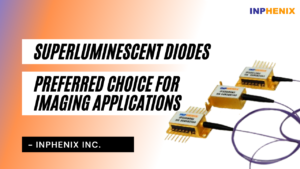
If you are associated with the light source or laser industry in any way– you must be well aware of the superluminescent diode light sources and their diverse applications. You may also know why superluminescent LEDs are the first choice for imaging applications.
But even in case you are new to this industry and know nothing about it– Never mind!
This article discussed what superluminescent diodes are, their salient characteristics, and why it is the preferred choice for imaging applications.
But before we jump to learn the relation between imaging applications & SLEDs, let us first understand what a superluminescent light emitting diode is and how it is different from or related to laser diodes (LDs) and light-emitting diodes (LEDs).

Wikipedia defines, the superluminescent light emitting diode or SLD or SLED is an edge-emitting semiconductor light source based on superluminescence. In simple terms, SLEDs are broadband semiconductor light sources based on superluminescence.
Although all of these diodes– superluminescent diodes, LDs, and LEDs belong to the same ‘family,’ there are considerable differences between their working and characteristics. Such as,
A. In laser diodes (LDs), a laser cavity is formed with an optical waveguide and reflective facets. Besides, the narrowband output is a result of amplified stimulated emission.
B. While in the case of light emitting diodes (LEDs), there is zero amplified gain, and the light emission takes place through the spontaneous emission only.
C. Whereas, in the case of superluminescent diodes or SLEDs, it uses the waveguide to capitalize on the process of amplified spontaneous emission and single pass, unlike multiple round trips in LDs.
Along with these superlative differences of SLEDs over LEDs and laser diodes, there are many other characteristics that make SLEDs– the favourable choice for the Imaging application.
Let us learn about those characteristics in the following section.
Following are the key characteristics that make superluminescent light emitting diodes a preferred choice for imaging applications.
A. Short temporal coherence,
B. Efficient coupling into single-mode fibers,
C. Divergence-limited light emittance,
D. Broadband optical spectrum,
E. Presence of the optical waveguide,
F. Linear polarization state, and
G. Amplified spontaneous emission
The short temporal coherence helps reduce speckle and interference noise. One such application is optical coherence tomography (OCT), which demands the least speckle and interference noise to generate real-time, cross-sectional images of high resolution.
The SLEDs are also very useful in making fiber optic gyroscopes. Gyroscopes are often used in navigation systems, satellite systems, and aerospace to measure the degree of rotation. Kindly note that a gyroscope is also a kind of imaging technique.
The short temporal coherence of the SLEDs also makes them an ideal choice for measuring load and vibration – such as in bridges. It is also used in measuring the temperature of various structures, including suspension bridges and skyscrapers.
To conclude, the amplified spontaneous emission and short temporal coherence are the two critical properties that make superluminescent diodes a preferred choice for imaging applications.
Inphenix is a laser and light source manufacturer with a business headquartered in California, USA. Along with superluminescent diodes, the company deals with a wide range of lasers and light sources, including semiconductor optical amplifiers, DFBs, swept-source laser, broadband light source, FP laser, and VCSELs, among others. Check out the company’s official website to know more about its services and products.
